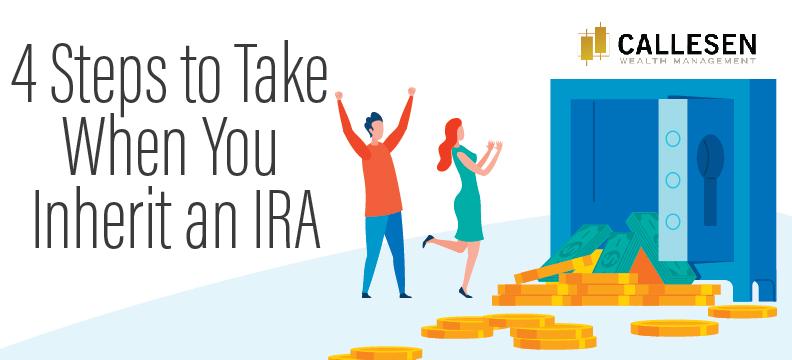
4 Steps to Take When You Inherit an IRA
It is becoming increasingly common for individuals to inherit retirement accounts from their family members or friends. However, it's important when inheriting such accounts that you follow particular steps in order to avoid making costly mistakes.
There are several options when you inherit a retirement account from someone else. Your options vary depending on a variety of factors including your relationship to the original account holder, the age of the original account holder when they passed away and the type of account you’ve inherited.
Here are four crucial steps to follow to increase your benefits in the long run:

Once you inherit an IRA you’ll want to make sure it’s set up properly. All retirement accounts need to be titled which means the name of an owner must appear on the account. If the deceased was a spouse you have the option to roll over (transfer) the amount of the inherited IRA into your own IRA account. An inherited IRA should have the name of the deceased original owner in the title and it should also indicate that the IRA was inherited.
Alternatively, if you’ve inherited an IRA from someone other than a spouse you will not be able to move money into your own IRA. In order to keep the tax benefits of the inherited account you will need to set up a new “Inherited IRA for Benefit of” followed by your name.2 After the account has been created, you’ll be able to transfer assets from the deceased persons account to your new “Beneficiary IRA”.

Your inherited IRA has a requirement that you take a distribution annually, called the Required Minimum Distribution. This distribution is taxable. If you are a spouse of the deceased then the prior year-end account value and life expectancy are needed to calculate the distribution amount on your inherited IRA. Prior to the SECURE Act passage, you would have had the option to withdraw the IRA funds annually over the entire span of your life. However, if you are a non-spousal beneficiary, you are now required to withdraw the whole account within 10 years if the deceased passed on or after January 1, 2020.3

Most beneficiaries are unaware if the IRA they’ve inherited has an after-tax basis. If you have inherited an IRA and you find out that it has an after-tax contribution you should fill out a Form 8606.4 By completing this form, you’ll be able to claim the non-deductible portion of the required minimum distribution.
You can always ask the executor if they are aware that the IRA has an after-tax contribution, but they might not know themselves and will need to refer to the tax returns of the deceased.

Taxation of distributions is different for Roth IRAs and other IRAs. In many cases, Roth IRAs have distributions that are tax-free if certain requirements are met. However, for other IRAs, the distributions are fully taxable. If the distribution is going to be taxable you should add that amount to your tax projection for the year to make the right decision on tax withholding.
As you make a plan for distribution, remember the SECURE Act’s new change for non-spousal beneficiaries. You will be required to distribute the entirety of the account within 10 years of inheriting it. Especially if the account is sizeable, this can have significant tax implications for you. Exceptions to this rule include:
- Disabled or chronically ill persons
- Minors
- Those who are less than 10 years younger than the deceased3
To avoid making costly errors, you should meet with a knowledgeable advisor as soon as you learn that you have inherited an IRA. Mistakes could mean larger taxes and complexities in the long run.
- https://www.forbes.com/sites/davidrae/2019/09/19/inheriting-an-ira/#6993dff82b7f
- https://www.congress.gov/bill/116th-congress/house-bill/1994/text?q=%7B%22search%22%3A%5B%22h.r.+1994%22%5D%7D&r=1&s=2#toc-H084B5EBD76DF47C0B895121999E2270E
- https://www.investopedia.com/articles/retirement/04/030304.asp
Securities offered through IFP Securities, LLC, d/b/a Independent Financial Partners (IFP), member FINRA/SIPC. Investment advice offered through IFP Advisors, LLC, d/b/a Independent Financial Partners (IFP), a Registered Investment Adviser. IFP and Callesen Wealth Management are not affiliated. Past performance is no guarantee of future returns. Investors cannot invest directly in an index. Diversification and asset allocation do not guarantee returns or protect against losses. The information given herein is taken from sources that IFP Advisors, LLC, dba Independent Financial Partners (IFP), IFP Securities LLC, dba Independent Financial Partners (IFP), and it advisors believe to be reliable, but it is not guaranteed by us as to accuracy or completeness. This is for informational purposes only and in no event should be construed as an offer to sell or solicitation of an offer to buy any securities or products. Please consult your tax and/or legal advisor before implementing any tax and/or legal related strategies mentioned in this publication as IFP does not provide tax and/or legal advice. Opinions expressed are subject to change without notice and do not take into account the particular investment objectives, financial situation, or needs of individual investors.



